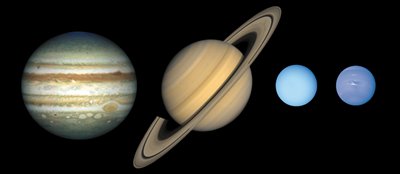 A Jovian planet is a gas giant, the term is derived from Jupiter which describes the three other gas giants in the Solar System as Jupiter-like. Though the name may imply it, a gas giant is not composed only of gas. It may have a metallic or rocky core, which is believed to actually be required for a Jovian planet to form, but the majority of its planetary mass is in the form of gases such as hydrogen and helium along with some traces of water, ammonia, methane and other hydrogen compounds.
A Jovian planet is a gas giant, the term is derived from Jupiter which describes the three other gas giants in the Solar System as Jupiter-like. Though the name may imply it, a gas giant is not composed only of gas. It may have a metallic or rocky core, which is believed to actually be required for a Jovian planet to form, but the majority of its planetary mass is in the form of gases such as hydrogen and helium along with some traces of water, ammonia, methane and other hydrogen compounds.
Unlike rocky planets such as the Earth and Mars, a Jovian planet does not have distinguishing characteristics between its surface and atmosphere. Its atmosphere gradually becomes denser toward the core, even having liquid states in between and at the core itself because of intense high temperatures. Because of this, one cannot actually “land on” such a planet in the traditional sense.
The gas giants of our Solar System are actually the outer planets Jupiter, Saturn, Uranus and Neptune, the latter two planets usually being referred to separately as the “ice giants” due to their being composed largely of ices, water, ammonia and methane. Common features among these four are their numerous satellites and rings, in addition, Uranus has a unique feature in that it rotates on its side due to an axial tilt of 97.77 degrees.
Planet Types Explained
